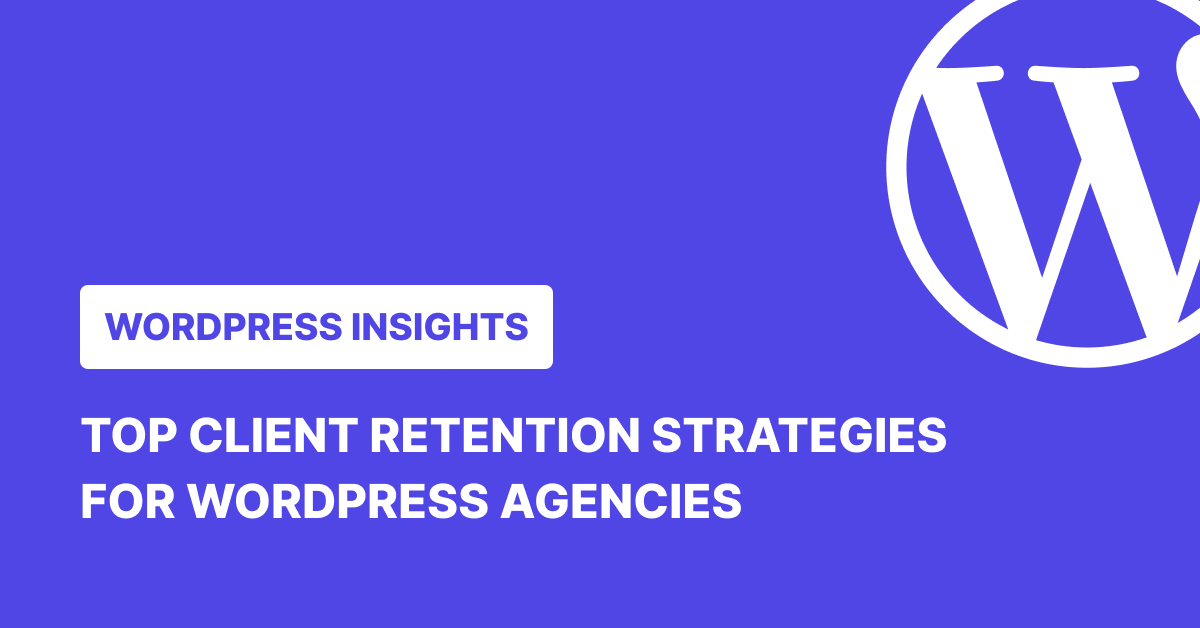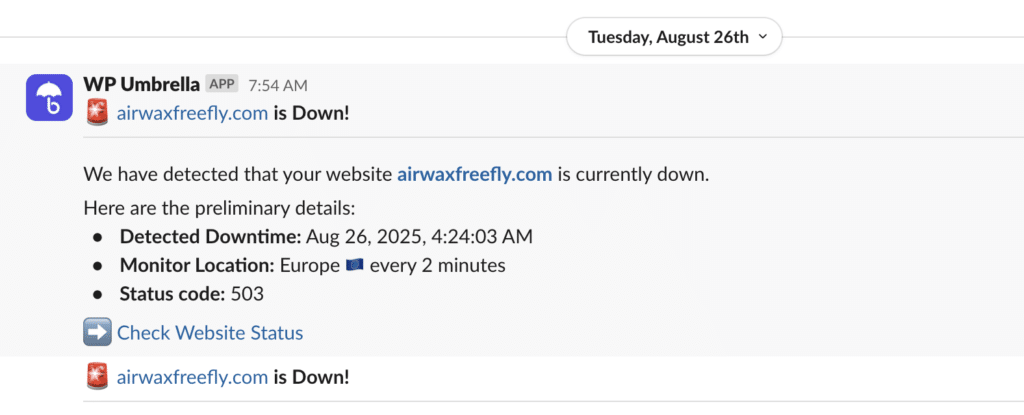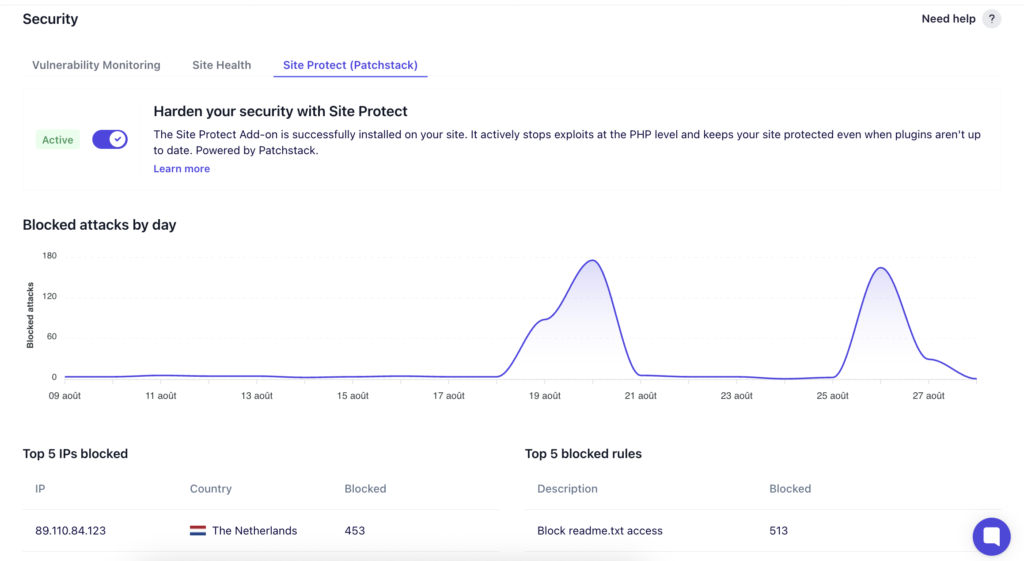Top Client Retention Strategies for WordPress Agencies

TL;DR
WordPress agencies improve client retention by tailoring their approach based on account size. Small clients value visibility, reliability, and simple check-ins. Enterprise clients expect documentation, predictable timelines, and internal alignment. WP Umbrella helps agencies stay consistent by automating updates, backups, monitoring, and reporting, making it easier to show value without extra manual work.
Keeping a WordPress client is almost always less expensive than replacing one. In fact, retention-focused agencies often see higher margins, steadier cash flow, longer client lifespans, and more referral volume than those chasing new builds every quarter. According to Bain & Company, improving client retention by just 5% can increase profits by up to 95%.
But retention doesn’t happen by default.
Even satisfied clients churn when communication trails off, or when the value of your work becomes less visible over time. Maintenance is quiet by nature, updates happen without fanfare, and reports may get missed by clients, especially when they’re too technical or too generic.
Plus, what drives retention in one segment doesn’t always translate to another. A small business might just want to know its site is safe, secure, monitored, and backed up. A larger account might expect monthly reports, milestone reviews, shared documentation, performance benchmarks, and clear alignment with their team’s marketing or ops objectives.
This blog outlines retention strategies for both ends of that spectrum and shares how agencies can adjust based on a client’s size, structure, timeline pressure, and appetite for visibility.
Retention starts with the right onboarding.
WordPress Client Retention: Small Clients vs. Enterprise Accounts
Most WordPress agencies don’t need to be told that small clients and enterprise clients behave differently. What often gets overlooked is how these differences manifest in day-to-day operations and their impact on retention over time.
In smaller accounts, decisions often sit with a single person. That person usually wears multiple hats and wants fast answers, minimal back-and-forth, and confidence that the site is being looked after. They’re less focused on documentation and more focused on feeling like they’re not alone when something goes wrong.
In larger accounts, communication gets layered. The person who approves the invoice might not be the one reading your emails or logging into the WordPress dashboard. These clients often work within internal processes: budget cycles, performance reviews, and timelines tied to campaigns or product launches. What they need from an agency is less about “support” and more about continuity, documentation, visibility, and reliability.
That shift (fewer expectations vs. formalized expectations) is where many agencies misstep. Treating every client the same often leads to under-communicating with the ones who need detail, or overwhelming the ones who don’t.
Top Client Retention Strategies for Small WordPress Clients
1. Prevent Client Churn by Staying Visible
Small clients don’t always leave with a cancellation notice. They often start fading out, and you stop hearing from them. Their invoices start arriving later and later. One day, you realize they haven’t replied to the last three messages, and the next thing you know, they’re gone.
That drift usually starts when communication becomes too transactional, or too quiet. A monthly check-in, even if it’s just two sentences, can be enough to stop it. The format doesn’t matter. What matters is that they know someone is still there, still keeping an eye on their site.
2. Use Client-Friendly Signals Instead of Technical Reports
Sending automated reports is standard. But if your client doesn’t open them, or doesn’t know what to do with them, they won’t help you keep the account. Small business owners are usually pressed for time, and they won’t dig through performance metrics to understand what you did.
Instead of explaining everything, highlight what changed. If something broke and you fixed it before they noticed, mention that. If you removed a plugin that had a vulnerability, make that the subject line. These moments don’t need framing, but they need clarity.
3. Build Retention Through Reliability
There’s often a gap between what a WordPress care plan covers and what a client thinks it includes. That gap widens if you’ve been quiet for a few months. It doesn’t matter if you’re doing the work. If the client can’t see it or doesn’t remember agreeing to it, they’ll start looking elsewhere.
Explain the scope clearly at the outset. Keep it somewhere the client can find it again. If you change something, say so. You don’t need to justify every line item. But if they’re left guessing, retention becomes guesswork too.
4. Set Clear Maintenance Pricing to Avoid Future Churn
When you work with a smaller client, you’re usually their only technical contact. They might not have staging environments or QA processes. They just know whether the site loads or not. If something breaks during their launch or while they’re on holiday, that’s the story they remember.
The agencies that keep these clients long-term aren’t the ones with a fancy tech stack. They’re the ones who quietly avoid creating emergencies. That’s not exciting work, but it’s the kind that ensures clients don’t leave.
Top Client Retention Strategies for Enterprise WordPress Clients
1. Give Them More Than Delivery
Larger clients often expect the work to be done well; that part’s table stakes. What they pay attention to is how you document, track, and follow through.
You can reduce pressure by keeping your reporting clean and forwardable. That might mean clearer summaries or simply responding with clarity when someone outside your usual contact loop starts asking questions. The aim is to reduce friction, not just for the client, but for the people they answer to.
2. Support the Internal Process
Your day-to-day contact probably isn’t making the final call on whether to keep your agency. That decision gets influenced by the quality of documentation, how easy it is to loop new people in, and whether your timelines match theirs.
Clients at this level need you to operate inside their ecosystem. When you’re slow to respond, it delays the task and holds up other teams. That friction adds up.
You don’t need to match their process perfectly, but you do need to understand how your delays affect theirs.
3. Help Them Make the Case
Agencies often assume they’ll get credit for a job well done. That’s not always how retention works. Your contact might be convinced, but someone higher up needs a reason to renew the contract, and that person probably hasn’t seen your work.
Retention depends on making your value easy to forward. A short note explaining why a migration was necessary. A record of response times during an incident. Materials that don’t need editing before they’re shared. That’s what keeps you in the budget.
4. Build a Track Record That’s Easy to Defend
Mistakes happen. That’s not what puts the account at risk; what does is inconsistency, such as slow recovery, patchy documentation, or unclear ownership when things go wrong.
Enterprise clients don’t need perfection, but they notice patterns. If your last three updates introduced problems or your team keeps shifting, someone eventually flags it.
Agencies that retain enterprise clients tend to make fewer promises and fewer resets. They keep the team stable, handle fixes without escalation, and ensure every issue has a paper trail. Over time, that makes your presence easier to defend.
How WP Umbrella Supports Client Retention
Automated Reporting

WP Umbrella quietly gathers what your clients should know, including backup status, uptime, updates, performance, and even analytics if you’ve linked Google Analytics, and turns that into a clear, branded report. It sends out those reports on a schedule you control, such as weekly or monthly, so the client stays informed without you having to manually assemble anything.
One Dashboard to Monitor Everything

Instead of bouncing between sites or dashboards, agencies see their entire portfolio in one place. You get bulk updates, unified monitoring, and a single view for backups, security checks, uptime, and PHP errors all at a glance.
Safe Updates and Backups

Updating WordPress can trigger compatibility problems. WP Umbrella has built-in safeguards, including Safe Updates, which creates restore points and rolls back changes if something goes wrong. Its backups are incremental, encrypted, compliant with GDPR, and can be scheduled hourly, daily, weekly, and monthly. And backup restoration takes one click.
Alerts When Something Breaks

You don’t find out a site is down when the client does. WP Umbrella monitors uptime, performance (like TTFB and PageSpeed), as well as PHP errors and potential security vulnerabilities. You get notified early, via Slack or email, so you can act before it becomes a crisis.
Hardened Security

WP Umbrella runs vulnerability scans every six hours using Patchstack, looking for risks in plugins, themes, and the core. It also flags things like SSL expiration or debug mode being enabled (small details that can expose clients to trouble).
To further harden security, Site Protect adds virtual patching and blocks plugin and theme vulnerabilities before an official update is available. It also stops common attack vectors (like file editing or user enumeration) and starts working immediately once enabled (using a toggle) without requiring any technical setup.
👉
Start your free trial of WP Umbrella.
Keep clients informed without extra overhead.
Conclusion
Some clients stay because they feel looked after. Others stay because your work makes theirs easier to defend. Either way, retention is about showing up in the ways that matter to clients, not you.
The habits that keep them aren’t complicated. They just have to be consistent. When updates go unnoticed, issues get flagged early, backups complete without error, and reports answer questions before they’re asked, there’s less reason to reconsider the relationship.
And that’s the point.
Clients don’t leave the first time something breaks. They leave when it keeps happening, and no one says anything.
FAQs about Client Retention Strategies
Usually, it’s not one thing. It’s the mix of steady delivery, clear updates, and the sense that someone’s paying attention. If they don’t have to chase you down for answers or worry about things slipping through the cracks, they tend to stick around. Retention looks like a lack of drama, not constant applause.
A good report doesn’t just list what happened. It gives context for why it matters. That doesn’t mean long explanations. It means showing the value of routine work before someone asks what the monthly fee covers.
Smaller clients often just want to know their site is safe and someone’s watching it. Larger clients care about workflows, accountability, and documentation. If you treat them the same, you’ll either overwhelm the small ones or under-serve the big ones.
They go quiet. Especially when everything’s working. Clients don’t always reach out when they’re unsure; you usually find out when they’ve already moved on. Even a short message saying “All clear this week” can keep that from happening.
It handles the part of the job that’s easy to forget but hard to scale: showing the client what you’ve done. Reports go out on time. Alerts come in early. Updates don’t break things. And you don’t need to build that system from scratch or remember to send a summary every Friday. It runs in the background, so your work stays visible without you having to perform.
